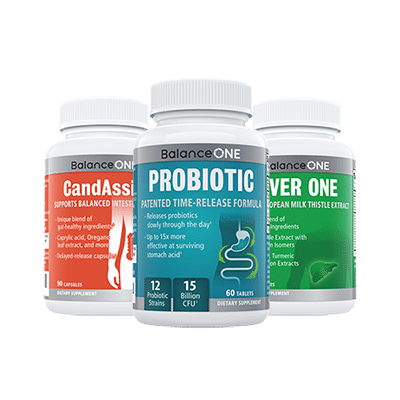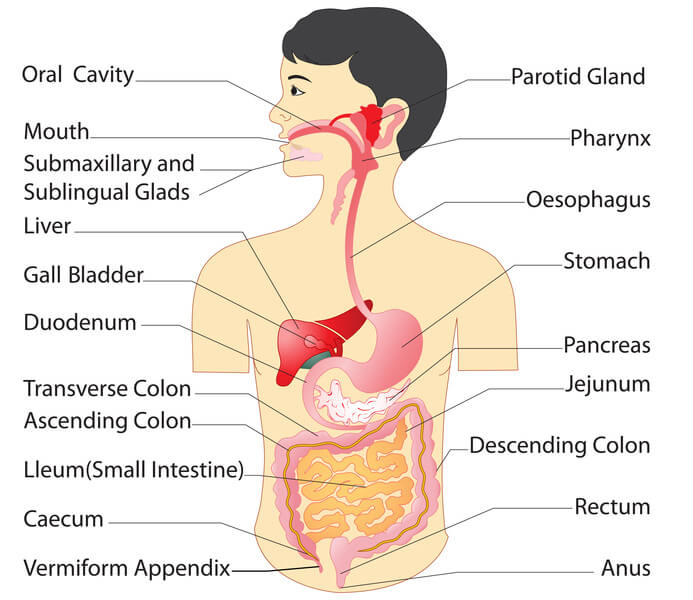Digestive System 101
While most people are familiar with the digestive system, they may not know how important it is or what exactly it does. Thanks to your digestive system, almost everything that you eat serves as potential fuel for your body.
This is why a healthy diet is so important, and why supplements like probiotics can play an important role in maintaining your digestive health.
What is Digestion?
When people eat, the food that they consume must be broken down so that their bodies can absorb it for nourishment and energy. This is a complex process that is known as digestion. There are two types of digestion that take place – manual and chemical.
Manual digestion is the breakdown of food by mechanical means, such as chewing. Peristalsis, which is the contraction of muscles that moves food through the digestive system, also mechanically breaks down the food. Chemical digestion is the breaking down of food by bodily secretions such as saliva, bile, enzymes and juices from the stomach and the small intestine.
- The Digestive System – An Overview
- Digestive System Functions – Mechanical and Chemical Digestion
- Digestion and Absorption – What is Digestion? (PDF)
- Digestive System
Main Parts of the Human Digestive System
The digestive system is more than a single part. It is a system of tubes and organs that begins with one’s mouth and ends with the anus. These parts can be divided into two groups – the gastrointestinal tract (GI) and the accessory organs. The accessory organs include the gallbladder, liver and pancreas, while all other parts belong to the GI tract. Regardless of which group the parts belong to, they are all critical to the digestive process.
- Mouth. The mouth is the first step in the digestive process. It is where liquids and food are taken in, and mastication takes place.
- Esophagus. The Esophagus is a tube that food and liquids travel down after they have been swallowed. This passage is connected to the stomach.
- Stomach. The stomach stores food and begins the digestion of proteins. The stomach also serves to kill bacteria.
- Pancreas. The pancreas sits behind the stomach and is attached to the duodenum by the pancreatic duct. Its job is to regulate the body’s blood sugar levels and to produce pancreatic juice, which aids the small intestine in the digestion of food.
- Gall Bladder. The liver produces bile that is collected in a small pouch beneath it called the gall bladder. When signaled, the gall bladder releases the bile into the small intestine to aid in the digestion of fats.
- Small Intestines. The small intestine is roughly 22 feet long and has three sections – the duodenum, jejunum, and the ileum. Most of the absorption of nutrients occurs in the small intestine.
- Liver. This is a three-pound, two-section organ that is located on the right side of one’s belly. It assists the digestive process by producing bile for the liver and filters digestive tract blood.
- Large Intestines. At five feet, the long intestine is significantly shorter in length than the small intestine, although it is broader. It has three parts – the cecum, colon, and rectum and it is responsible for absorbing salt and water from waste.
- Rectum and Anus. The rectum is the last portion of the large intestine where digestive waste, or stool, gathers until full. It is connected to the anus, which is the final part of the digestive system. The anus is like an exit from which the stool is released during defecation.
- Digestive System – The Stomach, Intestines, Liver and Pancreas
- The Digestive System – Introduction
- The Digestive System – Overview of Parts
- Anatomy of the Digestive System (PDF)
- The Digestive System
The Process of Digestion
The digestive process can be broken into five different steps. These steps include ingestion, propulsion, mechanical and chemical digestion, absorption and defecation.
The natural first step in this process is the ingestion of food. Once food enters the mouth the process of breaking it down begins, starting with the mechanical digestion that occurs when food is chewed into fine pieces and pulp. The propulsion of food via swallowing and peristalsis sends it through the system where further digestion takes place in the form of chemical digestion. Chemical secretions primarily in the stomach and small intestine are responsible for a majority of the chemical digestion that takes place. The small intestine is also where absorption, or the movement of nutrients into the blood, takes place. Defecation is the final step of the process as digestive waste leave the body.
- Digestion
- Overview of Digestive Processes
- The Digestive System – An Overview: How Does the Digestive Process Work?
- What are the Main Steps in the Digestive Process? (PDF)
- Digestion – Digestive Process
How to Maintain Healthy Digestion
To ensure that people receive the nutrients that they need to stay healthy, it is important that they take proper care of their digestive systems. This isn’t a complicated process, but it may require some changes to regular habits.
Losing excess weight to achieve and maintain a healthy body weight is one way to improve digestion. People can adopt a healthy eating regimen by avoiding foods that are fried and high in fat. Instead, they should eat fiber-rich foods like plenty of vegetables. When eating meat, they should select lean cuts and reduce the fat on poultry by removing the skin. Eating fermented foods will help to promote healthy digestion. Drinking plenty of water to stay hydrated and avoiding alcohol consumption is also helpful. Healthy eating and a healthy body weight will help the digestive process and decrease potential bowel problems.
Exercising for 30 minutes, five days a week will reduce instances of constipation. Stopping smoking and reducing stress are two more ways to safeguard digestive health. Both smoking and stress affect the digestive system in several, negative ways. Smoking, for example, may cause conditions such as cancer of the pancreas or esophagus.
- Avoiding Digestive Health Problems
- Digestive Health Tips (PDF)
- Ten Steps to Build and Maintain Digestive Health
- Digestive Health – Keeping Your Digestive System Healthy (PDF)
- Keeping Digestion on Track
Possible Digestive System Diseases and Complications
Any disorder, complication, or problem that takes place in the digestive system or tract is considered a digestive disease. Digestive diseases can range from mild problems to serious conditions that require ongoing care. Common problems include irritable bowel syndrome, lactose intolerance, gallstones, and hemorrhoids. Signs of digestive problems may include, but are not limited to, bloating, pain in the belly, bleeding, diarrhea, incontinence, heartburn, and nausea.
- Digestive Disorders
- Digestive System Diseases
- Digestive System Disorders (PDF)
- Diseases: Small Intestine
- Crohn’s Disease
Probiotics: How They Aid in Digestion
Another way to maintain healthy digestive function is to introduce live microorganisms known as probiotics into one’s diet. Probiotics (or ‘good’ bacteria) are a safe way to maintain the balance of good and helpful microorganisms in the intestines. They help ensure that the digestive system functions properly and that foods are properly absorbed.
Additional health benefits include relief from irritable bowel syndrome, antibiotic-related diarrhea, and inflammatory bowel syndrome, as well as a stronger immune system. Consuming yogurt with active cultures is one way to bring probiotics into one’s diet. Certain natural foods like kefir and sauerkraut are also good sources.
- Health Benefits of Taking Probiotics
- The Benefits of Probiotics (PDF)
- Probiotics (Beneficial Intestinal Bacteria)
- Probiotics and Prebiotics: Frequently Asked Questions (PDF)
- Probiotics for Healthier Digestion and Increased Immunity (PDF)
- Probiotics: What They are and What They Can do for You – Common Uses

3-Month Candida Elimination Kit Start Your 3-month Candida Cleanse
This Candida Kit contains all the supplements recommended on the Candida Diet:
- LIVER ONE to process and remove the toxins created by Candida.
- CANDASSIST to inhibit and weaken the Candida colonies in your gut.
- PROBIOTIC to replace the Candida yeast with probiotic bacteria.
Plus... the CANDIDA DIET RECIPE BOOK with 50+ low-sugar recipes


Leave a Reply